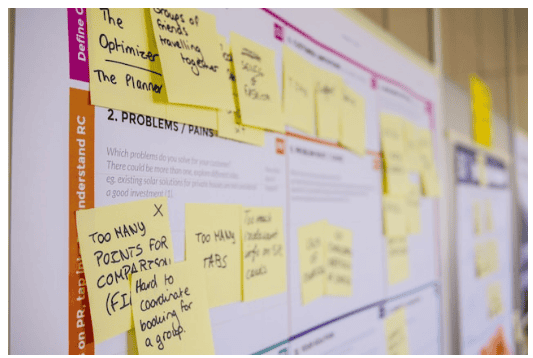How To Manage Time Effectively Using Themes
“Free time is the enemy of progress.”
Casey Owen Neistat is an American YouTube personality, filmmaker, and vlogger.
Free time can seem like giving yourself a break, but unstructured free time seldom results in relaxation and satisfaction. Even for me, I can fall into the trap of endlessly scrolling through Facebook and Instagram.
These apps are addictive as they are designed to keep you on an algorithm-curated feed for hours. We have a limited amount of personal resources, and the entire afternoon can disappear before you even know it.
And then you are rushing out the door as you are late for … “where was I supposed to be again?”
Unstructured free time can require much more effort to turn into something productive or enjoyable. Unless you have dedicated that time to relaxing, hobbies, or passion projects, it can quickly slip away with little fulfillment or accomplishment.
What is Time Management?
Time management is the strategic allocation of your day to maximize efficiency and productivity. It involves organizing tasks, setting priorities, and dedicating specific time to accomplish different activities.
Mastering this skill ensures that you make the most out of every moment, allowing you to achieve your goals while maintaining balance in your life. By learning to manage time effectively, you’re equipped to handle the pressures of daily demands with grace and ease, ensuring that you’re not just busy but also productive.
Why Do You Need Good Time Management Skills?
Ever feel like there need to be more hours in the day? Like you’re constantly chasing deadlines, juggling tasks, and sacrificing sleep just to keep up?
You’re not alone. But imagine a life where you’re in control, where you have the time and energy to pursue your passions, connect with loved ones, and achieve your goals. That’s the power of effective time management.
Recognizing the value of these skills, it’s clear that you need a structured approach to mastering them. This method is crafted to guide you through setting clear goals, prioritizing tasks, and reviewing your progress regularly. This approach isn’t just about working harder but smarter.
By tackling the most challenging tasks and efficiently managing your to-do lists to accomplish tasks more effectively, you combat poor time management. Integrating these good time management techniques into your daily routine means you’re not just surviving your schedule but thriving in it.
12 Ways How to Manage Your Time Effectively
Managing your time effectively is crucial to maximize productivity and achieve your goals. Here are some time management tips and techniques to help you manage your time more effectively:
#1) Prioritize Your Important Tasks
Prioritizing challenging tasks effectively is crucial in managing your time efficiently. Two well-regarded methods to help you sort through your daily responsibilities are the Eisenhower Matrix and the ABC Method.
Eisenhower Matrix
The Eisenhower Matrix is a powerful tool to help you prioritize your tasks based on urgency and importance. This method divides your tasks into four categories:
- Urgent and Important: Tasks that you need to deal with immediately.
- Important, but Not Urgent: Tasks that are important but do not require immediate action. Plan to do these tasks after they are urgent.
- Urgent, but Not Important: Tasks that need to be done soon but are less important. Delegate these if possible.
- Neither Urgent Nor Important: Tasks that are neither urgent nor important. These should be done last or eliminated altogether.
By categorizing your tasks in this way, you can focus on what truly matters, helping you manage your time more efficiently and effectively.
ABC Method
The ABC Method is another effective time management strategy for prioritizing tasks by assigning them a category based on their importance and urgency:
- A – Tasks that are vital: These are must-do tasks that are your highest priority.
- B – Tasks that are important but not critical: These are important but can wait if necessary.
- C – Tasks that are nice to do but not as important: These are tasks that are not critical and can be done if time permits.
This method encourages you to focus on the tasks that significantly impact your work and life, ensuring that you are always working in a priority-driven manner.
#2) Set SMART Goals
Ever heard the saying, “If you don’t know where you’re going, any road will take you there”? The same applies to successful time management. Without clear goals, it’s easy to get sidetracked and lose sight of what truly matters. That’s where SMART goals come in.
SMART stands for Specific, Measurable, Achievable, Relevant, and Time-Bound. By setting goals that meet these criteria, you’ll create a roadmap for your time, ensuring that every action you take is aligned with your desired outcomes.
Let’s dig into the meaning of SMART Goals:
- Specific: Define your goals with clarity and precision. Instead of saying, “I want to be more productive,” say, “I want to complete three major projects by the end of the month.”
- Measurable: Quantify your goals so you can track your progress. For example, instead of saying, “I want to read more,” say, “I want to read one book per week.”
- Achievable: Set goals that are challenging yet realistic. Don’t set yourself up for failure by aiming for the impossible.
- Relevant: Ensure that your goals are aligned with your values and priorities. Don’t waste time on activities that don’t contribute to your overall vision.
- Time-Bound: Establish deadlines for your goals to create a sense of urgency and focus. Instead of saying, “I want to start a business,” say, “I want to launch my business within six months.”
This method not only helps you focus on what’s important but also motivates you as you achieve each milestone, making your time management efforts both productive and rewarding.
#3) Use Time Management Tools
Leveraging time management tools can significantly enhance your ability to manage your schedule and tasks effectively. Here are three types of tools that you should consider integrating into your routine tasks to keep you on track and focused.
Calendars
Digital calendars, like Google Calendar or Outlook, are essential for scheduling and viewing your commitments at a glance. They help you plan your days, weeks, and months ahead, ensuring that you never miss an appointment or a deadline. You can set reminders for upcoming events and block time for deep work, making it easier to manage your daily activities.
Task Managers
Task managers such as Monday.com allow you to organize your projects and daily tasks efficiently. You can create lists, set priorities, assign deadlines, and even collaborate with others. These tools are excellent for keeping all your tasks in one place and visually tracking your progress toward completion.
Pomodoro Technique
The Pomodoro Technique is a time management method that encourages you to work with the time you have—rather than against it. Using a timer, you break your workday into 25-minute chunks separated by five-minute breaks.
These intervals are known as “Pomodoros.” After about four Pomodoros, you take a longer break of about 15 to 20 minutes. This technique helps maintain high levels of productivity by balancing focus with rest.
#4) Eliminate Distractions
Let’s face it, distractions are everywhere. It’s one of the common time management challenges. From social media notifications to chatty coworkers, it’s easy to get pulled away from your tasks. But with a few intentional strategies, you can create an environment that fosters focus and minimizes interruptions.
Create a Focused Work Environment
Your physical workspace plays a significant role in your ability to concentrate. Clear your desk of clutter, ensure adequate lighting, and maintain a comfortable temperature.
If possible, choose a quiet location where you won’t be interrupted by noise or conversations. Consider using noise-canceling headphones or playing calming music to further enhance your focus.
Turn Off Notifications
Every ping and buzz from your phone or computer is a potential time thief. Temporarily silence notifications for email, social media, and other apps that aren’t essential to your current task. If necessary, schedule specific times throughout the day to check your messages rather than responding to each one as they arrive.
#5) Avoid Multitasking
Contrary to popular belief, multitasking isn’t the productivity powerhouse it’s often made out to be. In fact, it can be quite the opposite.
Multi-tasking is a Myth
Our brains aren’t wired to handle multiple tasks simultaneously. When you try to multitask, you switch your focus rapidly between different activities, leading to decreased efficiency, increased errors, and a longer overall completion time.
Focus on One Task at a Time
Instead of multitasking, try single-tasking. Dedicate your full attention to one task at a time until it’s completed or you reach a natural stopping point. You’ll be surprised at how much more you can accomplish when you eliminate distractions and channel all your energy into a single endeavor.
#6) Use the Two-Minute Rule
Are you feeling overwhelmed by a lengthy to-do list? The Two-Minute Rule helps you gain momentum and make tangible progress. This straightforward principle suggests that any task requiring two minutes or less of your time should be completed immediately.
While seemingly simple, this strategy can have a profound impact on your productivity. Small tasks, when left unattended, can quickly accumulate and contribute to feelings of stress and overwhelm. By addressing them promptly, you free up mental bandwidth and foster a sense of accomplishment.
Moreover, the Two-Minute Rule can help you overcome the initial resistance often associated with starting a task. Once you begin, you may find yourself continuing beyond the initial two minutes, making significant headway on a project that previously seemed daunting.
#7) Practice Time Blocking
Time blocking is a powerful technique for taking control of your schedule and maximizing your productivity. It involves dividing your day into dedicated blocks of time, each allocated to specific tasks or activities.
Schedule Specific Times for Specific Tasks
Rather than simply creating a to-do list, assign specific time slots for each task. This provides a clear structure for your day and helps you avoid the trap of constantly reacting to incoming demands. Be realistic about how long each task will take, and allocate enough time to complete it without rushing.
Include Breaks and Buffer Time
Don’t forget to schedule breaks throughout your day. These are essential for maintaining focus, preventing burnout, and recharging your energy. Additionally, buffer time between tasks should be included to allow for unexpected interruptions or delays.
Check Out Focus Blocks
If you find it challenging to stay on track, consider using a tool like Focus Blocks. This app helps you create and maintain a time-blocked schedule, track your progress, and identify areas where you may lose focus.
#8) Break Down Large Projects
Are you overwhelmed by a massive project looming over your head? Don’t let it intimidate you! Tackle it with a strategic approach:
- Divide into Manageable Tasks: Break down large projects into smaller, actionable steps. Instead of viewing it as one giant undertaking, dissect it into smaller, bite-sized tasks. This makes the project feel less daunting and provides a clear roadmap for what needs to be done.
- Set Milestones: Establish key milestones along the way. These are checkpoints to track progress and celebrate achievements, keeping you motivated and on track toward your ultimate goal.
#9) Track Your Time
Understanding how you spend your time can help you identify patterns, pinpoint time-wasters, and make informed decisions about optimizing your schedule. Think of it as a personal audit for your hours and minutes.
Here are two tools to help you track your time effectively:
Toggl
Toggl is a user-friendly time-tracking app that allows you to start and stop timers for different tasks throughout the day. You can categorize your activities, generate reports, and analyze how your time is distributed across various projects.
Rize
Rize is an intelligent time-tracking tool that automatically tracks your computer activity and categorizes it for you. It also provides insights into your focus patterns, helping you understand when you’re most productive and how to create a schedule that aligns with your natural rhythms.
#10) Automate, Delegate, or Outsource Tasks
Not all tasks require your direct involvement. Free up your schedule by strategically handing off certain responsibilities.
Identify Tasks to Automate Using Sofware or AI
Many repetitive and time-consuming tasks can be automated with the right tools. Think about data entry, email filtering, or social media scheduling. By automating these processes, you’ll reclaim valuable hours for more meaningful work.
Identify Tasks to Delegate to Your People
If you have a team, consider delegating tasks that don’t require your unique expertise. This not only frees up your time but also empowers your team members and allows them to develop their skills.
Identify Tasks to Outsource to External People
For specialized tasks that fall outside your area of expertise, consider outsourcing to freelancers or agencies. This can be a cost-effective way to get high-quality work done without sacrificing your own time and resources.
#11) Review and Reflect
Time management isn’t a “set it and forget it” kind of deal. It’s an ongoing process that requires regular check-ins to ensure you’re staying on track and making the most of your time.
Daily Review
Take a few minutes at the end of each day to review your accomplishments and identify areas for improvement. Did you stick to your schedule? Were there any unexpected interruptions? What can you do differently tomorrow?
Weekly Review
Dedicate a longer block of time each week to assess your overall progress. Are you moving closer to your goals? Are there any patterns emerging in how you spend your time? What adjustments can you make to optimize your schedule further?
Check Out Sunsama
Sunsama is a daily planner and journal app designed to help you reflect on your day, plan for the future, and stay focused on what truly matters. It offers features like daily task prioritization, timeboxing, and guided reflections.
#12) Maintain a Healthy Work-Life Balance
Remember, time management isn’t just about squeezing more work into your day. It’s about creating a life that’s fulfilling both personally and professionally.
- Set Clear Boundaries: Define clear boundaries between your work and personal time. Establish specific work hours and stick to them as much as possible. When you’re off the clock, disconnect from work-related emails and notifications.
- Learn How to Say No: Don’t overcommit yourself. It’s okay to say no to requests that don’t align with your priorities, or that would stretch you too thin. Politely decline and explain that you’re focusing your time elsewhere.
- Take Care of Your Well-being: Prioritize your physical and mental health. Get enough sleep, eat nutritious foods, exercise regularly, and engage in activities that bring you joy. A well-rested and healthy person is more productive and better equipped to manage your time effectively.
Taking it to the Next Level: How to Manage Time Using Themes
Time Theming is a time management method in which a focus or theme is established for a specific period of time.
We can establish themes for a single year, known as the “Annual Axiom.” These ideas can also be applied to days, months, or weeks for “Weekly Sprints.” Lastly, themes can span multiple days, known as “Horizontal Themes.”
Themes can be revolutionary because they structure your time by assigning an underlying idea to concentrate on during that period of time. These focuses can be applied regardless of whether you prefer to finish your work based on deadlines or priorities.
Instead of constantly worrying about what you have to do for a given month, week, or day, time theming will help remove that sense of unknown and anxiety. This productivity method also enables you to concentrate on specific work items when you are overwhelmed.
1) Work backward from your certainties.
Your certainties are the facts that you know to be true or events that will happen. We may have big work projects, personal activities, or the school year in our lives that fill up our calendars. These realities will provide you with the boundaries around which to build your themes.
Example: A certainty could be that your kids always start school in September every year. Thus, you can institute the monthly theme of “Going Back to School” for September to help orient everyone in the family. The theme would help you and your family prioritize activities so your kids can start their school year successfully.
2) Themes are funnels or filters for your focus
Themes will help you manage your time and work based on your assigned theme for that time period. This time management method provides a default state for your mind when you drift off course. Without assigned themes to help provide direction, getting sidetracked may result in being overwhelmed or engaging in activities that do not help you achieve your goals.
Example: Let’s suppose that you find yourself running out of clothes or getting behind on your bills. You can pick a day of the week (Sunday) and assign the theme for that day to be “Chores and Admin.” When Sunday comes around, your mind will be directed toward working on your finances, yard work, laundry, etc. This would help you regularly work on your Chores and Admin, which results in rarely running out of clothes and paying your bills on time.
3) Do not let anomalies derail your ability to do work related to the theme
We all have anomalies in our schedules that don’t fit with the activities related to our assigned theme for a given time period. However, we should not let these activities derail our focus from the assigned theme for that time period. Additionally, we should leave room for work that needs to be done that is not related to the assigned theme.
Example: Let’s say Sunday is our Chores and Admin day, and you take your kids to a birthday party for another kid in their class. This activity is an anomaly as you usually start doing your Chores and Admin work from the beginning of the day. After the birthday party, you don’t let this activity stop you from getting some of your Chores and Admin done.
4) Choose time themes that are practical for a given time period
You want to choose the most practical idea for a given time period. Considerations such as the climate, holidays, work schedules, etc., will affect when a given theme is appropriate for a specific time of year or time period.
Example: Let’s suppose you live in Canada, and one of your New Year’s resolutions is to improve your gardening skills to grow different vegetables and herbs. It would not be reasonable to assign “Gardening” as the theme for January because it is not sensible in wintertime when it is too cold to grow anything and work outside for long periods of time. It would be more appropriate to pick April for “Gardening,” as the start of spring.
5) You don’t have to theme everything.
You may need to develop a theme for everything in your life and work. However, only some periods require a time theme or need to, as it may not make sense or be unnecessary.
Also, it may be tempting to plan and manage our time using themes far in advance, but it is not recommended, as our plans and themes will probably be wrong or likely to change.
Annual Axiom: Time Theming Your Year
Give yourself a time theme for the year to motivate and guide you for the year. Some ideas can come from the mottos of sports teams, inspirational quotes, or spiritual verses.
It is crucial to make it your own so you can strongly identify with your Annual Axiom. My Annual Axiom for 2024 is: “Just Do It. You’ll make mistakes along the way, but you’ll learn and grow.”
Monthly Themes: Time Theming Your Months
Establish themes for most of the months in the coming year. Again, not every month needs a theme; you can assign or change them later in the year as necessary.
Weekly Sprints: Time Theming Your Weeks
For projects that are doable in seven days or less, you can establish a “Weekly Sprint” for that week. You can theme certain intensive weeks but should not theme all of them. Weekly sprints should be spread throughout the year so you do not burn out.
Final Thoughts on Effective Time Management

Mastering time management is a journey, not a destination. It takes time, practice, and a willingness to experiment with different strategies to determine what works best for you. Remember, the goal isn’t to become a robot who rigidly adheres to a schedule but to gain control over your time so you can live a more fulfilling and productive life.
By implementing these 12 proven techniques, you’ll be well on your way to becoming a time management pro. You’ll reduce stress, increase productivity, and achieve your goals with greater ease and confidence.
So, what are you waiting for? Start reclaiming your time today, and watch as your life transforms into one of greater purpose, balance, and joy.








Love your annual axiom share! Great post.